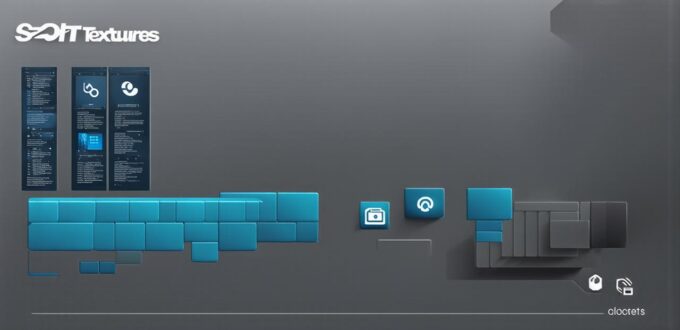Types of Software: An Overview
There are several types of software, each with its own unique features and characteristics. Here is an overview of the most common categories:
Operating Systems
Operating systems (OS) are the foundations upon which all other software runs. They provide a platform for applications to run on and manage hardware resources such as memory, storage, and input/output devices. Examples of modern operating systems include Windows, macOS, Linux, Android, and iOS.
Application Software
Application software is designed to perform specific tasks for users. These programs can be used for a variety of purposes, including word processing, spreadsheet analysis, graphic design, and more. Examples of application software include Microsoft Office, Photoshop, and Final Cut Pro.
Middleware
Middleware is software that acts as an intermediary between different systems or applications. It allows different software components to communicate with each other and exchange data in a standardized way. Examples of middleware include message queues, connection pools, and transaction managers.
Database Software
Database software is designed to manage and store large amounts of data. These programs allow users to create, update, and retrieve information from a database using structured queries or programming languages such as SQL. Examples of database software include MySQL, Oracle, and Microsoft SQL Server.
Web Software
Web software is designed to run on the internet and can be accessed by anyone with an internet connection. This includes everything from simple static websites to complex web applications that use server-side scripting languages like PHP or JavaScript frameworks like React or Angular. Examples of web software include Google, Facebook, and Amazon.
System Software
System software is designed to manage the operations of a computer system, including operating systems, middleware, and utilities. Examples of system software include anti-virus software, firewalls, and device drivers.
Understanding the Characteristics of Each Category
Now that we have an overview of the different types of software let’s dive into the characteristics of each category:
Operating Systems
Operating systems are designed to be flexible, adaptable, and secure. They provide a standard interface for applications to interact with hardware resources, making it easier for developers to create programs that run on multiple platforms. Some of the key features of operating systems include:
- Memory management: OS manage memory allocation and deallocation to ensure efficient use of system resources.
- File management: OS manages file storage and access, providing a standard way for applications to read and write data.
- Process management: OS manages the execution of programs, including scheduling processes, allocating resources, and terminating processes when necessary.
- Security: OS provides security features like firewalls, user authentication, and access control to protect against threats.
Application Software
Application software is designed to perform specific tasks for users. These programs are typically standalone applications that run on the user’s computer or device. Some of the key features of application software include:
- User interface: Application software has a graphical user interface (GUI) or command-line interface (CLI) that allows users to interact with the program.
- Functionality: Application software is designed to perform specific tasks, such as word processing, spreadsheet analysis, graphic design, etc.
- Data storage: Application software can store data locally on the user’s device or remotely in the cloud.
- Customization: Application software can be customized to meet the needs of individual users or organizations.
Middleware
Middleware is designed to facilitate communication between different systems or applications. It provides a standard way for software components to exchange data, making it easier for developers to integrate different systems and applications. Some of the key features of middleware include:
- Message passing: Middleware uses message passing to transmit data between different software components.
- Protocol translation: Middleware translates protocols between different software components, ensuring that they can communicate with each other regardless of their underlying technology.
- Resource pooling: Middleware manages resources such as memory and I/O devices, allowing multiple software components to share these resources efficiently.
Database Software
Database software is designed to manage and store large amounts of data. These programs allow users to create, update, and retrieve information from a database using structured queries or programming languages such as SQL. Some of the key features of database software include:
- Data storage: Database software stores data in tables that can be organized by various attributes like primary keys and foreign keys.

- Query processing: Database software allows users to create queries to retrieve, insert, update, or delete data from the database.
- Security: Database software provides security features like user authentication, access control, and encryption to protect against threats.
Web Software
Web software is designed to run on the internet and can be accessed by anyone with an internet connection. This includes everything from simple static websites to complex web applications that use server-side scripting languages like PHP or JavaScript frameworks like React or Angular. Some of the key features of web software include:
- Client-server architecture: Web software follows a client-server architecture, where the client sends requests to the server and the server responds with data.
- Platform independence: Web software is platform independent, meaning it can run on any device or operating system that has an internet connection.
- Scalability: Web software is highly scalable, making it easy to add new features and functionality as needed.
System Software
System software is designed to manage the operations of a computer system, including operating systems, middleware, and utilities. Some of the key features of system software include:
- Resource management: System software manages hardware resources like memory, storage, and input/output devices, ensuring efficient use of these resources.
- Security: System software provides security features like firewalls, user authentication, and access control to protect against threats.
- Backup and recovery: System software provides backup and recovery tools to ensure data can be restored in the event of a system failure or data loss.
Choosing the Right Software Category for Your Needs
When designing software, it’s important to choose the right category based on your needs. Here are some guidelines to help you make an informed decision:
- Determine the purpose of your software: Before choosing a software category, determine what your software is designed to do. This will help you narrow down the options and choose the best category for your needs.
- Consider the type of data you’ll be working with: Different software categories are better suited for different types of data. For example, database software is ideal for managing large amounts of structured data, while web software is ideal for managing data that needs to be accessed from anywhere with an internet connection.
- Think about scalability: Some software categories are more scalable than others. Web software and system software are highly scalable, making them a good choice for applications that need to grow and adapt to changing requirements over time.
- Consider security: Security is an important consideration when designing software. Different software categories provide different levels of security, so choose the category that best meets your needs.
